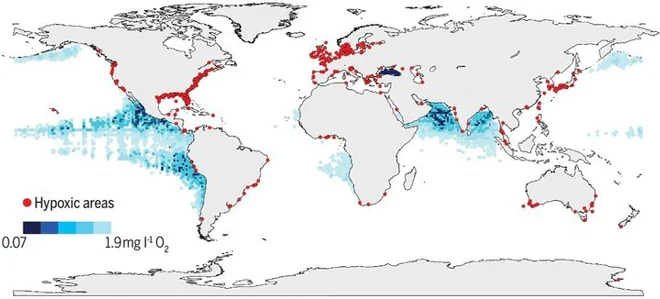The size of oxygen-deprived ocean “dead zones”, where plants and animals fight for survival, has quadrupled around the world, a new scientific analysis reports.
The increase in the size of these zones is another consequence of global warming, including an increase in the ocean temperature caused by greenhouse gases, and, closer to the coast, contamination with agricultural wastewater and sewage.
“The increase in the supply of nutrients to the oceans along with climate change – both caused by human activities – change the biogeochemistry of the ocean and increase oxygen consumption,” says a study published in the journal Science. Ultimately, such changes are “destructive and the result of them can be the destruction of an ecosystem that will cause social and economic damage.”
The analysis of oxygen-deprived zones was carried out by a team of scientists from the Global Oxygen Network, established in 2016 by the Intergovernmental Oceanographic Commission of the United Nations.
Researchers have determined that zones with a minimum oxygen content in the open ocean have increased since 1950 to an area roughly equal in size to the European Union. The volume of ocean water, completely devoid of oxygen, increased during this time by almost four times. The number of hypoxic or oxygen-poor zones along the coast increased to 10 times, from 50 to 500.
Oxygen is the basic element necessary for life in the oceans. The parts of the ocean lose oxygen, and dead zones become unsuitable for the habitation of many organisms.
The threat exists not only for life in the oceans, which contain almost half of the planet’s oxygen. Major extinctions in the history of the Earth were associated with a warm climate and oxygen deficiency in the oceans.
The consequences for ocean life can be significant even in areas where oxygen is simply not enough. In such areas, animals may lag behind in development, and their immune responses weaken. The result will be low survival rates and a reduction in healthy diversity, scientists warn.
Scientists say that oxygen-poor areas can be saved by slowing climate change and reducing nutrient pollution. To do this, it is necessary to protect especially vulnerable areas and create areas that are free from fishing, and also to improve the supervision of areas where the oxygen level is going down.
But even with “ambitious rates of emission reductions,” computational models predict “further loss of oxygen during the 21st century.”
The increase in the size of these zones is another consequence of global warming, including an increase in the ocean temperature caused by greenhouse gases, and, closer to the coast, contamination with agricultural wastewater and sewage.
“The increase in the supply of nutrients to the oceans along with climate change – both caused by human activities – change the biogeochemistry of the ocean and increase oxygen consumption,” says a study published in the journal Science. Ultimately, such changes are “destructive and the result of them can be the destruction of an ecosystem that will cause social and economic damage.”
The analysis of oxygen-deprived zones was carried out by a team of scientists from the Global Oxygen Network, established in 2016 by the Intergovernmental Oceanographic Commission of the United Nations.
Researchers have determined that zones with a minimum oxygen content in the open ocean have increased since 1950 to an area roughly equal in size to the European Union. The volume of ocean water, completely devoid of oxygen, increased during this time by almost four times. The number of hypoxic or oxygen-poor zones along the coast increased to 10 times, from 50 to 500.
Oxygen is the basic element necessary for life in the oceans. The parts of the ocean lose oxygen, and dead zones become unsuitable for the habitation of many organisms.
The threat exists not only for life in the oceans, which contain almost half of the planet’s oxygen. Major extinctions in the history of the Earth were associated with a warm climate and oxygen deficiency in the oceans.
The consequences for ocean life can be significant even in areas where oxygen is simply not enough. In such areas, animals may lag behind in development, and their immune responses weaken. The result will be low survival rates and a reduction in healthy diversity, scientists warn.
Scientists say that oxygen-poor areas can be saved by slowing climate change and reducing nutrient pollution. To do this, it is necessary to protect especially vulnerable areas and create areas that are free from fishing, and also to improve the supervision of areas where the oxygen level is going down.
But even with “ambitious rates of emission reductions,” computational models predict “further loss of oxygen during the 21st century.”
Tags
Natural catastrophe
